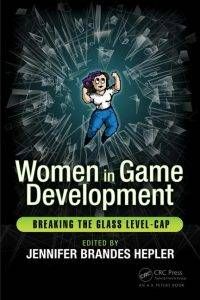
Up Your Geek Stats with an Insider Look at the World of Video Game Development
I’m a woman who works in STEM and is involved in the gaming industry, so it’s entirely possible I’m biased when I say this is one of the best books I’ve read this year. Women in Game Development: Breaking the Glass Level-Cap, is aimed at a fairly specific demographic: women with a passion for video games who might be wondering how to break into what is, at times, a very hostile industry for women. But if you don’t fall into either of those categories, don’t worry; you certainly don’t have to be a lady or a gamer to give this superb and informative collection a read.
 The book is edited by veteran game developer Jennifer Brandes Hepler (probably best known for her work as a writer at BioWare on the Dragon Age series of video games), and contains 22 personal essays from a wide range of contributors. Each of these women work in different facets of game development, including writers, engineers, technical artists, designers, producers, CEOs, and everything in between. In the space of a short chapter, each of these women speak about how they first fell in love with video games, how they broke into the industry–and how they managed, or didn’t manage, to stay there.
The book is edited by veteran game developer Jennifer Brandes Hepler (probably best known for her work as a writer at BioWare on the Dragon Age series of video games), and contains 22 personal essays from a wide range of contributors. Each of these women work in different facets of game development, including writers, engineers, technical artists, designers, producers, CEOs, and everything in between. In the space of a short chapter, each of these women speak about how they first fell in love with video games, how they broke into the industry–and how they managed, or didn’t manage, to stay there.
The chapters are loosely grouped by profession, each section capped with supplementary chapters by Hepler which provide additional information, advice, and resources for both women trying to find their place in the industry and for allies already inside who can help make more diverse teams possible. Even in the book’s happiest success stories, it’s clear: none of these women had an easy road to get where they wanted to be, or to keep their place there once they earned it.
Even if you don’t pay attention to video games at all, you’re probably aware that these days, being a woman with opinions about video games–much like being a woman with opinions about comics–can be a pretty dangerous thing to be. This danger has escalated in the past five years or so, with the anonymity of the internet allowing more and more trolls to threaten, stalk, doxx, attack, and even drive women from their homes. Their supposed crimes? Pointing out problematic elements in video games. Working in video games. Daring to be publicly part of a space that they actually make up over half of.
Yeah, we’ve all heard this story before. We’re all sick to death of hearing this story. But the story keeps happening, and while Women in Game Development isn’t directly about this abusive culture, it is a book that is very much born in a time where this sexism (and racism, and homophobia, and body-shaming, and everything else they can throw at you) is a part of daily life in video games, in ways both subtle and blatant. On the one hand, this book is a victorious declaration. Here are twenty-two women who made it work, in twenty-two different ways. And they are women who will not be silenced, who are out in the thick of the industry doing amazing and empowering things through determination, guts, resilience, talent, and above all, a burning passion for video games. But the collection isn’t just a celebration of these isolated successes; it’s also looking forward, a vow to keep fighting to make things better.
This is a book published for everyone, but it’s a book that is primarily written for, and speaking to, the women who will come next. Many of the contributors emphasize the importance of various mentors in their career paths, and this book is working very consciously to help pay that good support forward. This book is speaking, at times directly, to the women who will come next. The ones who need to know what it takes, how many approaches and destinations there are within the vast field of game development. Who need to know how much of a better place the industry has become, thanks to women like those in this book, but also how much further it still has to go.















